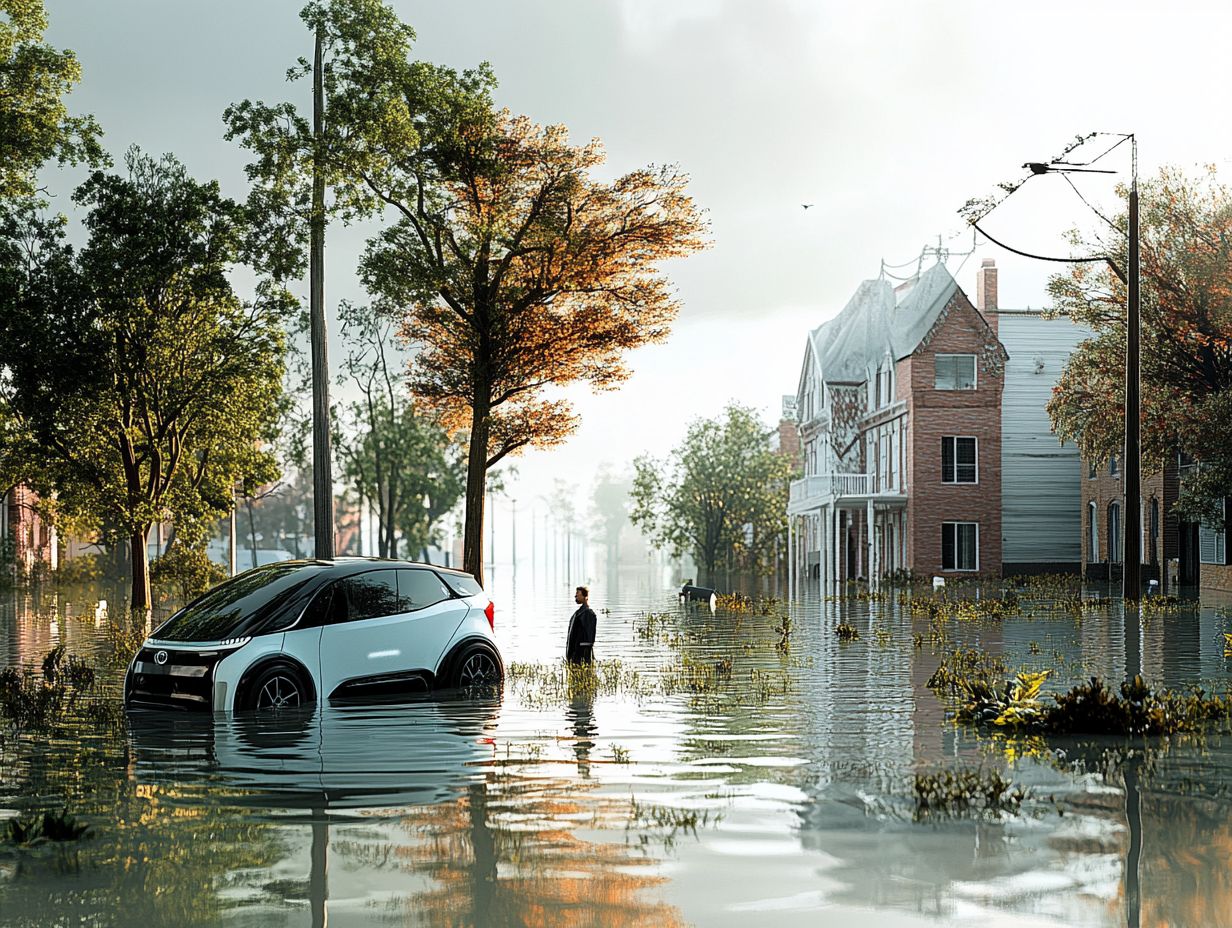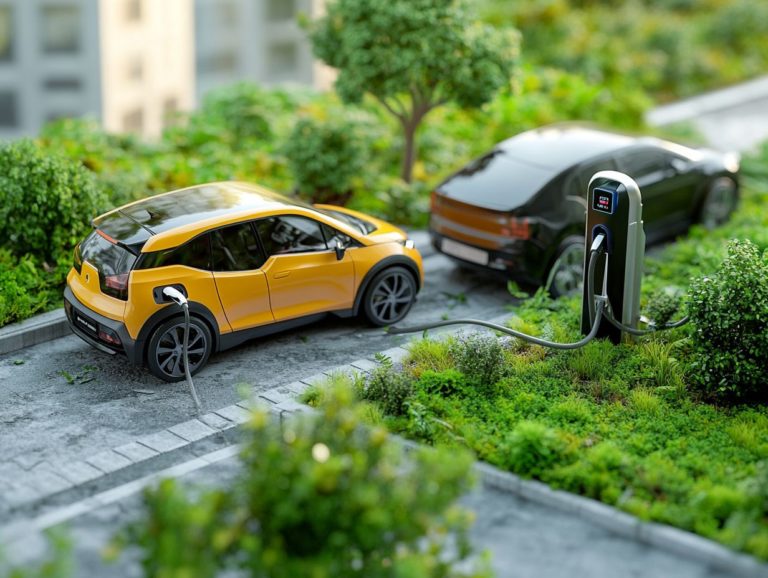Can I Drive an EV in a Flooded Area?
As electric vehicles (EVs) gain traction in the automotive landscape, it’s crucial for you to grasp their technology and the unique challenges they face.
One of the more pressing challenges is flooding. It poses significant risks to EVs and raises questions about safety and damage.
This article explores how flooding affects EVs. It also offers guidelines for navigating flooded areas, emergency measures if your vehicle is compromised, and alternative transportation options.
Whether you already own an EV or are contemplating the switch, this guide is designed to help you navigate these waters both literally and figuratively.
Contents
- Key Takeaways:
- Understanding Electric Vehicles (EVs)
- Effects of Flooding on EVs
- Precautions for Driving an EV in a Flooded Area
- Emergency Measures for a Flooded EV
- Alternative Transportation Options
- Frequently Asked Questions
- Driving an EV in Flooded Areas: What You Need to Know
- What precautions should I take when driving an EV in a flooded area?
- What should I do if my EV gets stuck in floodwater?
- Can driving an EV in a flooded area damage the vehicle?
- How can I protect my EV from flood damage?
- What should I do if water enters my EV during a flood?
Key Takeaways:

- Electric vehicles (EVs) are vulnerable to flood damage, which can lead to costly repairs and safety hazards.
- It is important to take precautions when driving an EV in a flooded area. Avoid deep water and inspect the vehicle afterwards for any potential damage.
- If your EV is flooded, follow emergency measures such as turning off the power and seeking professional assistance. Consider alternative transportation options if necessary.
Understanding Electric Vehicles (EVs)
Understanding Electric Vehicles (EVs) is essential in today s automotive landscape, particularly as the world increasingly embraces sustainable driving solutions. EVs use powerful batteries and electric motors that set them apart from traditional petrol vehicles.
By relying on electric power rather than petroleum, they significantly reduce emissions and create a positive environmental impact. This makes them an appealing choice for consumers who prioritize sustainability in their driving decisions.
Overview of EV Technology
Electric vehicle technology encompasses various systems crafted to elevate performance, including advanced electrical systems and battery protection measures that effectively prevent issues like thermal runaway, a situation where a battery could overheat and catch fire.
Modern electric vehicles boast sophisticated battery management systems that continuously monitor the health and efficiency of the battery. This proactive strategy ensures optimal charging and discharging cycles, significantly reducing wear and extending the lifespan of the battery.
Innovative safety features are built in to reduce risks during collisions or challenging driving conditions. These include reinforced structures and intelligent crash detection systems that can activate protective measures in an instant.
By prioritizing battery safety and structural integrity, manufacturers are making remarkable strides in delivering reliable and safe electric vehicles, ultimately enhancing your confidence as you navigate the road ahead.
Effects of Flooding on EVs
The impact of flooding on electric vehicles (EVs) can be quite severe, presenting considerable risks to both the vehicle s structural integrity and the safety of its occupants. Floodwaters can damage essential components, including the battery pack and electrical systems, which can elevate the risk of electric vehicle fires.
You need to understand these risks, particularly in areas vulnerable to extreme weather events like hurricanes and summer storms, where the dangers associated with driving increase dramatically.
Potential Risks and Damage

The potential risks and damage that flooding poses for electric vehicles often arise from exposure to standing water. This can cause short circuits in electrical systems and ultimately lead to complete vehicle failure.
Beyond electrical issues, such inundation can disrupt various structural components. This includes the battery casing, the parts that manage your vehicle’s functions, and wiring harnesses. Your electric vehicle, designed with complex energy management systems, becomes particularly vulnerable when faced with excess moisture.
Environmental agencies play a crucial role in assessing these risks by monitoring flood zones and providing guidelines for safe vehicle operation after a flood.
Statistical data from insurance companies reveals a troubling trend: many electric vehicles are classified as total losses following flooding due to staggering repair costs. Understanding these challenges is essential for vehicle owners and policymakers to effectively mitigate future risks.
Precautions for Driving an EV in a Flooded Area
Taking precautions while driving an electric vehicle (EV) in a flooded area is essential for your safety and the long-term health of your vehicle.
- Familiarize yourself with safety criteria, such as the maximum wading depth for your specific EV model.
- It’s crucial to have emergency response measures in place for unexpected flooding.
By following these guidelines, you can significantly enhance your vehicle s safety during challenging weather conditions.
Guidelines for Safe Driving
When navigating flooded roads, adhering to safe driving guidelines is essential to minimize risks and ensure your vehicle remains secure.
Start by assessing the water’s depth before you proceed. Even water that appears shallow can hide dangerous conditions beneath the surface.
Look for indicators like debris or moving currents, as these can signal powerful currents or potential hazards lurking below. Maintaining control of your vehicle requires a gentle touch on the steering wheel avoid sudden movements that could lead to a loss of traction.
Your situational awareness is crucial; keeping a watchful eye on other drivers and the surrounding environment allows you to make informed decisions. Above all, staying calm and composed can truly make a difference in this unpredictable landscape.
Emergency Measures for a Flooded EV
If there is a flooding incident, having a clear understanding of emergency measures for your electric vehicle (EV) can be the difference between a minor inconvenience and a catastrophic situation.
Immediate emergency response is necessary to assess risks such as battery damage and the potential for vehicle fires. These can occur after the vehicle is submerged or subjected to a collision with floodwaters.
Steps to Take in Case of Flooding

If your electric vehicle (EV) encounters flooding, it s essential to act swiftly to ensure safety and evaluate any potential damage to the battery or electrical systems.
First and foremost, remain calm panic won t serve you well in this situation. If you find yourself in rising water, prioritize your personal safety; make sure all passengers evacuate quickly and calmly.
As you step out, be vigilant in seeking stable ground, steering clear of water that could be deeper than it appears. Once you re safely out of the vehicle, maintain a safe distance, as it may still present electrical hazards.
After ensuring everyone is safe, reach out to a professional. They can thoroughly assess any possible water damage to your EV s battery and electrical systems, which is crucial for both safety and performance. This step not only aids in identifying potential issues but also helps prevent further complications in the future.
Alternative Transportation Options
When faced with the risks of flooding, it’s crucial to look for alternative transportation options that prioritize safety and enhance your situational awareness, especially in areas prone to severe weather events.
Public transportation is a safe option, effectively reducing your exposure to the dangers associated with driving and environmental hazards during floods.
Considerations for Using Public Transportation
Using public transportation during flooding requires careful thought, particularly regarding your safety and understanding the impacts on transit systems.
As a traveler, check the operational status of local services. Heavy rainfall may disrupt schedules and routes with little warning. Access official transit websites or their social media channels for real-time updates now to stay safe during flooding!
Following safety guidelines during emergencies is essential. Stay clear of flooded areas, as water levels can rise unexpectedly, posing significant risks. Be aware that emergency response protocols may severely limit transit availability, with certain routes suspended or modified to prioritize safe evacuations.
By understanding these factors, you can navigate your journeys more effectively during severe weather events.
Frequently Asked Questions
Driving an EV in Flooded Areas: What You Need to Know

Yes, it’s possible to drive an EV in a flooded area. However, take precautions to ensure your safety and your vehicle s safety.
What precautions should I take when driving an EV in a flooded area?
First, ensure that the water level is not above the bottom of your car’s doors. If it is, do not attempt to drive through the flooded area. Avoid driving through fast-moving water or water that is deeper than 6 inches.
What should I do if my EV gets stuck in floodwater?
If you become stuck in floodwater, do not attempt to start the car or push it out. Instead, call for assistance and wait for professional help. Starting the car or pushing it could damage the electrical components.
Can driving an EV in a flooded area damage the vehicle?
Yes, driving an EV in a flooded area can harm the vehicle’s electrical components. It’s important to avoid flooded areas to prevent potential damage.
How can I protect my EV from flood damage?
To protect your EV from flood damage, it’s best to park it in a safe, elevated area during flood events. If you lack access to an elevated area, consider using sandbags to create a barrier around the car to prevent water from reaching it.
What should I do if water enters my EV during a flood?
If water enters your EV during a flood, do not start the car. Instead, have it towed to a certified dealership or mechanic for inspection and repairs. Ignoring potential damage could lead to costly repairs later on.
Have you dealt with floods before? Share your experiences and tips for staying safe in the comments!






